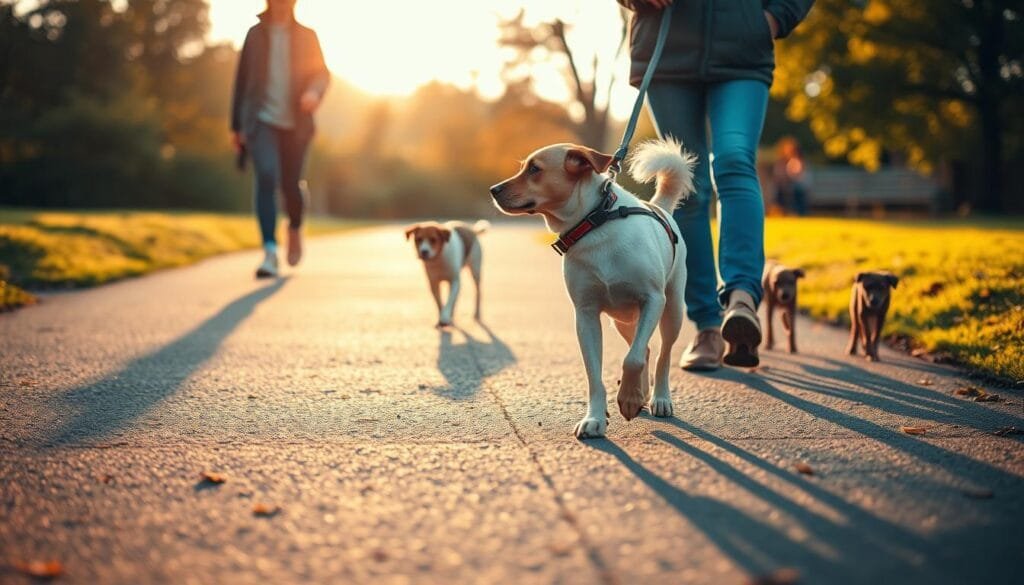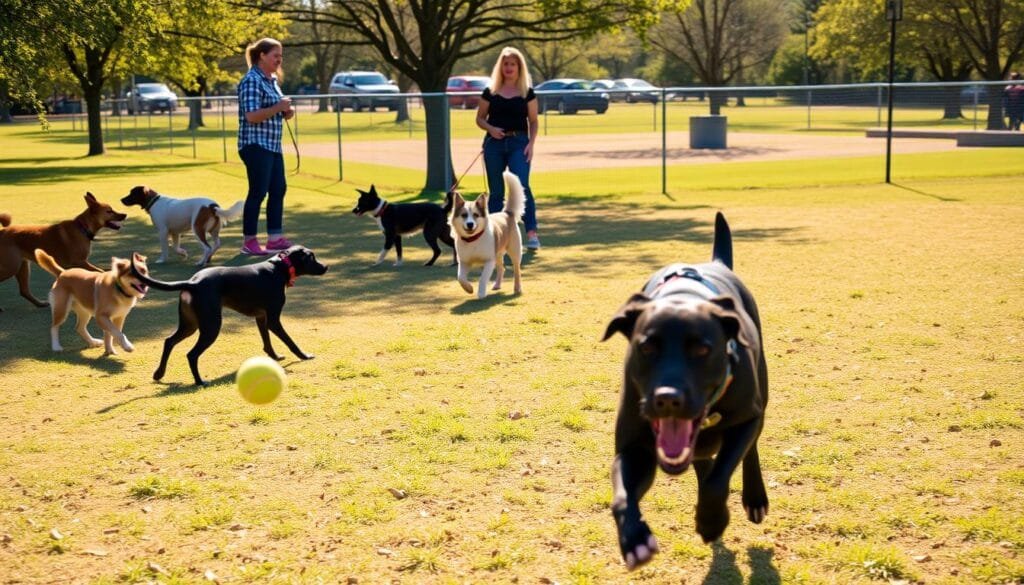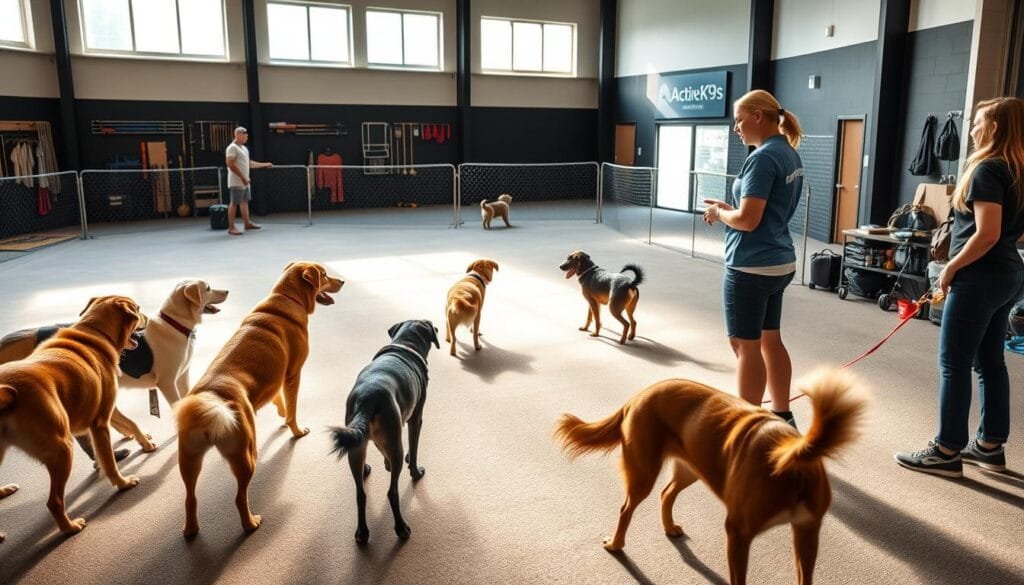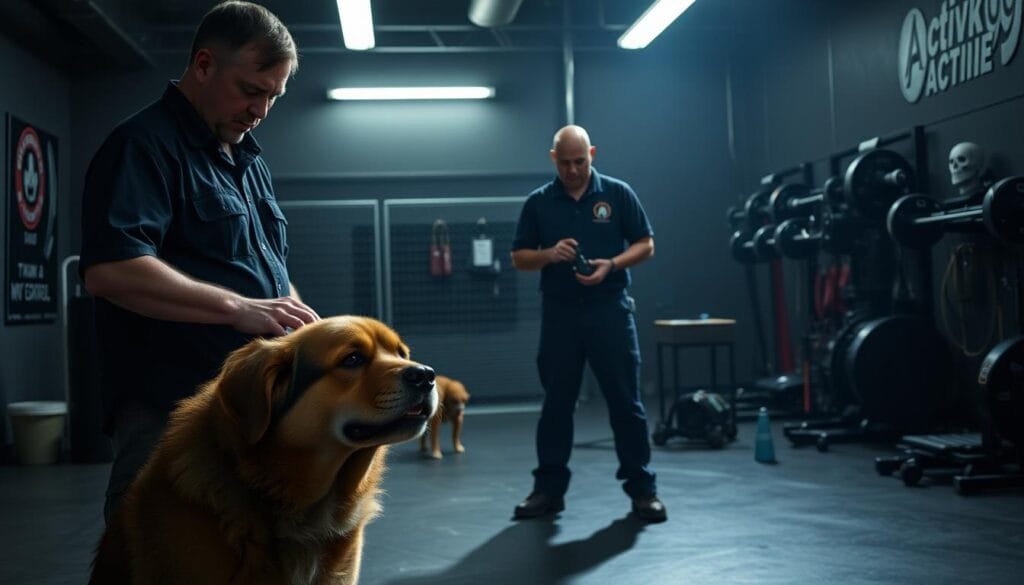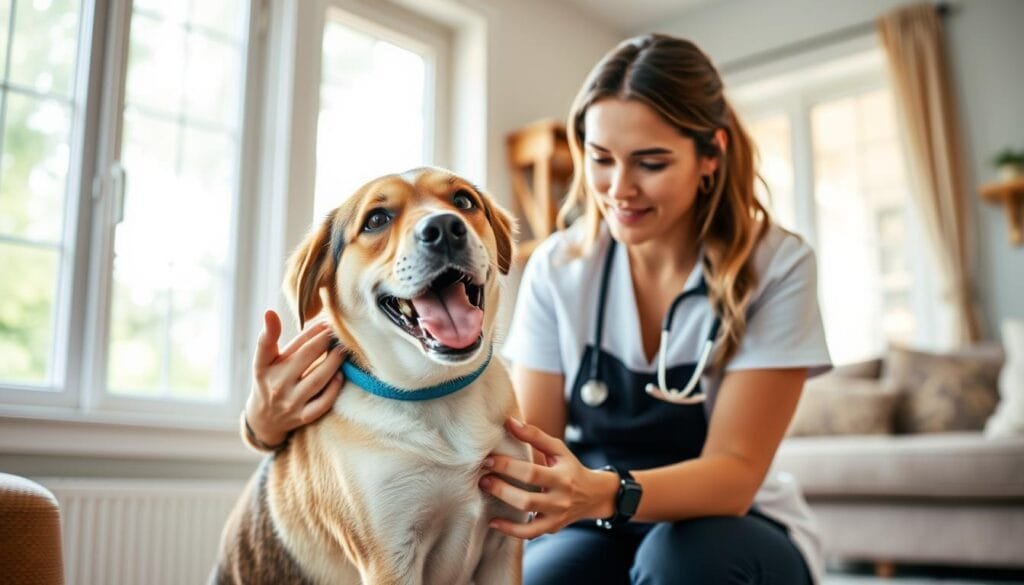Unlock the Secrets of Bernese Mountain Dog Training
Did you know that gentle giants like these fluffy companions thrive best with tailored guidance? In Ireland, breed-specific techniques make all the difference in shaping well-behaved, happy pets. That’s where activk9s steps in, offering expert mobile training led by certified trainer Malcolm.

Whether you’re in Clonmel or Tipperary , their proven methods focus on positive reinforcement, ensuring your furry friend learns without stress. This guide covers vet-approved strategies, from basic commands to advanced tricks, all designed for their unique temperament.
Key Takeaways
- Breed-specific approaches enhance results for these large, affectionate dogs.
- Positive reinforcement ensures stress-free learning.
- activk9s provides mobile training across Ireland (089-4120124).
- Certified trainer Malcolm specialises in gentle, effective techniques.
- Practical, vet-approved methods suit all skill levels.
Understanding Your Bernese Mountain Dog
Early guidance shapes these large pups into well-mannered adults. Their gentle nature and intelligence make them eager to please, but their size—up to 50kg—demands consistent training from the start. Knowing their traits helps tailor your approach for the best results.
Breed Traits and Temperament
Originally bred as working dogs, they thrive on structure and purpose. Their calm demeanour masks a sharp mind, meaning they pick up commands quickly. However, their strength means mistakes in training can lead to hard-to-break habits.
Socialisation is critical between 3–14 weeks. Introduce your puppy to new sights, sounds, and people during this window. Miss it, and you might face unnecessary challenges later.
Why Early Training Matters
Starting young prevents issues like pulling on leads or jumping up. Their size makes these behaviours harder to correct in adulthood. Short, positive sessions work best—their attention span matches their patience.
| Trait | Training Implication | Health Note |
|---|---|---|
| Gentle | Responds poorly to harsh methods | Prone to joint issues |
| Intelligent | Learns quickly with rewards | Monitor exercise intensity |
| Large size | Leash manners are essential | Avoid stairs for puppies |
Their working heritage means they enjoy tasks. Incorporate mini “jobs” like carrying a light backpack to channel energy constructively. Always prioritise joint health—low-impact activities like swimming are ideal.
Essential Bernese Mountain Dog Training Techniques
Patience and the right approach make learning enjoyable for both of you. These gentle giants respond best to positive reinforcement, where rewards trump punishment. Keep sessions short initially—just 5 minutes—to match their attention span.
https://www.youtube.com/watch?v=0g2OrtYV7V8
Short, Engaging Sessions
Start with brief training sessions, gradually increasing to 15 minutes as focus improves. Two to three daily bursts work better than one long drill. Always end on a high note, like a successful sit or stay.
Using Treats Effectively
High-value rewards like Chippin Cricket Jerky are ideal. Break soft, smelly treats into pea-sized pieces to avoid overfeeding. Pair them with a marker—a clicker or a cheerful “Yes!”—to signal correct commands.
Correcting Unwanted Behaviours
A firm “Stop” followed by redirection works best. Never punish; instead, guide them toward the right action. Consistency is key—reward good behaviour every time to reinforce habits.
- Progress session length slowly: 5 → 10 → 15 minutes.
- Use markers (“Yes”/clicker) for clear communication.
- Redirect, don’t scold, for lasting results.
Mastering Basic Commands
Mastering basic commands lays the foundation for a well-behaved companion. These skills not only improve obedience but also strengthen your bond. Start with simple instructions like “sit” and gradually progress to more complex tasks.
Teaching the Sit Command
Follow this 7-step process to teach “sit” using marker training:
- Hold a treat near your pup’s nose.
- Slowly move your hand upward and backward, guiding their head.
- As their bottom lowers, say “sit” and click/mark.
- Immediately reward with the treat.
- Repeat 5–7 times per session.
- Gradually reduce hand luring, using only the verbal command.
- Practise in different locations for consistency.
Progressing to Stay and Come
Once “sit” is mastered, introduce “stay”:
- Ask your pup to sit, then say “stay” while holding your palm out.
- Wait 2 seconds, then reward. Increase duration slowly.
- Add distance by stepping back gradually.
For a reliable “come”:
- Use a leash in a quiet area. Say their name + “come” cheerfully.
- Gently reel them in if needed, rewarding immediately.
- Practise with increasing distractions over time.
| Command | Key Technique | Common Issue |
|---|---|---|
| Sit | Lure with treat + verbal cue | Slow response |
| Stay | Build duration incrementally | Breaking position |
| Come | High-value rewards | Distractions |
If responses lag, check for overtraining or low-value rewards. Short, positive sessions always yield the best results.
Advanced Training for Bernese Mountain Dogs
Once your fluffy companion masters the basics, it’s time to elevate their skills. Advanced techniques refine their behaviour, ensuring they adapt seamlessly to various situations. Consistency and patience remain key, especially for larger breeds.

Building on Foundational Skills
Introduce complex commands like “leave it” and “heel” to enhance control. Start in low-distraction areas, gradually increasing difficulty. For “leave it,” place a treat on the ground, cover it, and reward only when they ignore it.
Transitioning from food rewards to verbal praise encourages independence. Phase out treats slowly—pair them with enthusiastic praise like “Good job!”—until verbal cues alone suffice.
Socialisation Strategies
Adult bernese mountain dogs benefit from controlled socialisation. Expose them to new environments, sounds, and people in short, positive bursts. Avoid overwhelming them; instead, let them observe from a distance first.
- Use quiet parks or pet-friendly cafés for practice.
- Reward calm behaviour around strangers.
- Introduce other animals gradually, always on-lead.
Their natural carting instincts make task-specific training rewarding. Teach them to carry lightweight items in a backpack—this channels energy constructively while reinforcing obedience.
For leash walking, practise direction changes and sudden stops to improve responsiveness. A well-fitted harness ensures comfort and control during sessions.
Positive Reinforcement: The Key to Success
Reward-based methods transform obedience into joyful collaboration between you and your pet. Rooted in operant conditioning, positive reinforcement strengthens desired behaviours by linking them to pleasant outcomes. This scientific approach isn’t just effective—it builds trust and enthusiasm for learning.
Studies show that consistent reinforcement accelerates skill retention. For example, marking correct actions with a clicker or verbal cue (“Yes!”) followed by a treat creates clear cause-and-effect understanding. Over time, your companion associates compliance with rewards, making repetition natural.
Crafting Sustainable Routines
Balance is crucial. Follow these principles to avoid common pitfalls:
- Mix reward types: Alternate treats with playtime or affection to prevent over-reliance on food.
- Phase out gradually: Reduce treat frequency while increasing verbal praise, ensuring skills persist without constant incentives.
- Timing matters: Deliver rewards within 1–2 seconds of the desired behaviour to reinforce the connection.
Individual motivation varies. Some pets thrive on crunchy snacks, while others prefer tug-of-war sessions. Observe what excites your companion most, and tailor reinforcement accordingly. This personalised approach keeps training engaging and effective.
“Dogs repeat what works. If sitting earns a chicken treat, they’ll offer sits more often—it’s that simple.”
Avoid these missteps to maintain progress:
- Inconsistent cues (e.g., using “Down” instead of “Lie”).
- Rewarding too late, confusing the intended action.
- Neglecting to phase out food rewards, risking obesity.
With patience and the right strategy, your pet will master commands eagerly—no force required.
Common Training Challenges and Solutions
Training hurdles are normal, but breed-specific solutions make overcoming them simpler. Whether it’s stubbornness or distractions, tailored techniques keep progress on track. Consistency and the right rewards transform frustration into success.
Dealing with Stubbornness
Some pups test boundaries more than others. Patience is vital during these phases—avoid frustration by shortening sessions and upping rewards. High-value treats like salmon bites reignite enthusiasm.
For persistent resistance:
- Redirect gently: Swap unwanted actions with a command they know (e.g., “sit” instead of jumping).
- Stay upbeat: End sessions early if needed, finishing with an easy win.
- Ignore attention-seeking: Turn away from nudging or barking, rewarding calm behaviour instead.
Overcoming Distractions
Outdoor training requires *gradual exposure*. Start in quiet spaces, slowly introducing busier areas. Use a reward hierarchy—save the best treats for high-distraction zones.
| Challenge | Solution | Tool |
|---|---|---|
| Stubbornness | Shorter sessions + premium treats | Clicker/marker word |
| Distractions | Controlled environments first | Long-line leash |
| Low focus | Engagement games (hide-and-seek) | Squeaky toy |
If progress stalls, a professional trainer like activk9s can pinpoint overlooked issues. Their mobile service adapts to your pup’s unique needs.
Nutrition for Optimal Training Results
Fueling your pup’s growth with the right nutrients sets the stage for successful training. A balanced diet supports cognitive function, joint health, and energy levels—key for a responsive, eager learner. Tailor meals to their life stage for maximum impact.
Puppy vs Adult Dietary Needs
Puppies require specialised food until 18 months to prevent joint strain. Opt for large-breed formulas with 18–26% protein and moderate fat (under 16%). Feed 3–4 meals per day until 6 months, then reduce to twice daily.
Adults thrive on fewer calories but need supplements like omega-3s for mobility. Transition diets gradually over 7–10 days to avoid digestive upset.
Choosing the Best Food
Prioritise AAFCO-compliant options with:
- Joint-supporting ingredients (glucosamine, chondroitin).
- High-quality proteins (chicken, salmon) for muscle development.
- Prebiotics for gut health—essential for nutrient absorption.
| Life Stage | Meals/Day | Key Nutrients |
|---|---|---|
| Puppy (2–6mo) | 3–4 | DHA, calcium |
| Adult (18mo+) | 2 | Omega-3s, fibre |
For training treats, pick soft, pea-sized options. Reserve 10% of their daily calories for rewards to avoid overfeeding. Rotate flavours to maintain interest during sessions.
Health Considerations in Training
Training isn’t just about commands—it’s about safeguarding their physical health too. Large breeds like these need tailored routines to avoid strain. Proactive care ensures they thrive both mentally and physically.

Joint Care During Exercise
Puppies grow rapidly, making controlled exercise vital. Avoid high-impact activities like jumping until they’re fully grown. Instead, opt for:
- Structured walks on soft surfaces to protect developing joints.
- Swimming sessions, which build strength without pressure.
- Short play bursts—5–10 minutes—to prevent exhaustion.
Watch for signs of discomfort: limping, reluctance to move, or stiffness after rest. Early intervention with your vet can prevent long-term issues.
Recognising Breed-Specific Risks
Nearly 11% develop arthritis by age 4, so weight management is key. Feed measured meals to avoid obesity, which worsens joint stress. For bloat (GDV), follow these steps:
- Serve smaller meals 3–4 times daily.
- Restrict vigorous activity for an hour after eating.
- Learn emergency signs—pacing, drooling, or a swollen belly.
“Routine vet checks catch issues early, letting you adjust training before problems escalate.”
Collaborate with your vet to tailor routines for mobility challenges. Ramps, orthopaedic beds, and low-impact commands (*gentle*, *steady*) support their life quality. Remember: a healthy canine is a trainable one.
Why Choose Professional Bernese Mountain Dog Training
Professional guidance transforms training from a challenge into a rewarding journey. With certified expertise, you’ll address breed-specific needs while building a stronger bond with your companion.
Benefits of Working With activk9s
activk9s delivers mobile training in Tipperary adapting to your schedule and environment. Their approach combines science-backed methods with patience, ensuring stress-free progress for your pet.
Key advantages include:
- Customised programmes: Tailored to your family’s lifestyle and your pup’s personality.
- Ongoing support: Phone and email guidance between sessions keep you on track.
- Proven results: Success stories highlight improved obedience and confidence in large breeds.
What to Expect From Trainer Malcolm
With years of experience in behavioural management, Malcolm specialises in gentle, effective techniques. His certification ensures your pup learns safely, whether mastering basics or advanced commands.
His process includes:
- Initial assessment to identify goals and challenges.
- Step-by-step plans with clear milestones.
- Regular progress reviews to adapt strategies.
“Every dog deserves a trainer who understands their unique quirks—Malcolm’s patience makes all the difference.”
Ready to start? Contact activk9s at 089-4120124 for a consultation. Whether in Clonmel or Tipperary their mobile service brings expertise to your doorstep.
Conclusion
Consistency is the cornerstone of a well-behaved, happy companion. With time and patience, positive reinforcement builds trust and lasting results. Remember, these gentle giants thrive on routine—short, engaging sessions work best.
Given their typical lifespan of 6–8 years, every moment counts. Whether mastering basics or tackling challenges, professional support ensures progress. activk9s offers tailored guidance across Ireland, adapting to your pet’s unique needs.
Ready to transform your dog’s behaviour? Call Malcolm at 089-4120124 for personalised training solutions. Your journey to a happier, better-mannered companion starts today.
FAQ
What makes Bernese Mountain Dogs unique in terms of training?
Their gentle nature and intelligence make them responsive to positive methods. However, their size and strength mean consistency is crucial from an early age.
How long should training sessions last for this breed?
Keep sessions short—10 to 15 minutes—to maintain focus. Their attention span works best with frequent, rewarding interactions.
What’s the best way to use treats during training?
Use high-value rewards sparingly to motivate without overfeeding. Pair treats with verbal praise for balanced reinforcement.
How do I stop my dog from pulling on the lead?
Teach loose-leash walking by stopping when they pull and rewarding when they return to your side. A front-clip harness can help manage their strength.
Are group classes or one-on-one training better for this breed?
Puppy classes aid socialisation, but private sessions with experts like activk9s address specific needs, especially for larger adolescents.
What health precautions should I take during training?
Avoid excessive jumping to protect joints. Monitor for overheating and opt for cooler times of day for exercise.
Can older Bernese Mountain Dogs learn new commands?
Absolutely. Their willingness to please makes them adaptable. Adjust pace and rewards to suit their energy levels.
How does professional training with Malcolm differ from DIY methods?
Malcolm’s expertise in large breeds ensures tailored strategies for obedience and behaviour, saving time and preventing common mistakes.
Source Links
- Bernese Mountain Dog, Bernese Mountain Dog Training AAA… – https://www.goodreads.com/book/show/24535604-bernese-mountain-dog-bernese-mountain-dog-training-aaa-akc-think-like
- Bernese Mountain Dog 101: Owner’s Guide – https://gratefulpaw.com/bernese-mountain-dog-training
- Complete Guide to the Bernese Mountain Dog Breed – https://tameandwildstudio.com/blogs/t-w-tails/bernese-mountain-dog-breed?srsltid=AfmBOopxXgUOfALrDudzWqE0EA-swJHljPFJJxAJ-_ssi9W_jWrGQ_GS
- No title found – https://www.akc.org/expert-advice/advice/train-bernese-mountain-dog-puppy-milestone-timeline/
- 12 Secrets for Teaching a Bernese Mountain Dog Puppy Obedience – https://iheartdogs.com/12-secrets-for-teaching-a-bernese-mountain-dog-puppy-obedience/
- How to train a Bernese Mountain Dog – Dress Up Your Pup – https://www.dressupyourpup.com/how-to-train-a-bernese-mountain-dog/?srsltid=AfmBOopXz-nP0H_QtWt7u5raz8Ch5hSDUZvM7S6UBMum4BKchNGzc3V2
- How to train a Bernese Mountain Dog – Dress Up Your Pup – https://www.dressupyourpup.com/how-to-train-a-bernese-mountain-dog/?srsltid=AfmBOorW-lgg5aKZ19IaSLPvhDOm4vAayNjxWcdwsfzWVF7P8eEPEQtn
- What are the First 5 Commands to Teach a Puppy | Beyond the Dog – https://beyondthedogtraining.com/puppy-training/what-are-the-first-5-commands-to-teach-a-puppy/
- Bernese Mountain Dog Training: Berners Best Behavior – Berner Mountain Dog – https://bernermountaindog.com/bernese-mountain-dog-training-101/
- The Bernese Whisperer Book: Advanced Techniques for Training, Understanding, and Bonding with Your Bernese Mountain Dog – https://tailoredread.com/book/bernese-whisperer-advanced-techniques-training-understanding-18b8714d373a
- How to train a Bernese Mountain Dog – Dress Up Your Pup – https://www.dressupyourpup.com/how-to-train-a-bernese-mountain-dog/?srsltid=AfmBOoqVGJTr6oHH1C5P61C4Vi_zIhVIJNRgT-IpG6HcexEeBYYDUAOh
- No title found – https://www.akc.org/expert-advice/training/operant-conditioning-positive-reinforcement-dog-training/
- How to Train a Bernese Mountain Dog (7 Vet-Approved Tips) – Dogster – https://www.dogster.com/dog-training/how-to-train-a-bernese-mountain-dog
- No title found – https://www.akc.org/expert-advice/training/common-dog-training-mistakes/
- No title found – https://www.akc.org/expert-advice/nutrition/train-bernese-mountain-dog-puppy-milestone-timeline/
- Bernese Mountain Dog – https://www.petmd.com/dog/breeds/bernese-mountain-dog
- Dog Food Feeding Berner Puppies and adults – http://www.bmdinfo.org/bernerpedia/Dog_Food_Feeding_Berner_Puppies_and_adults.php
- Bernese Mountain Dog Care: Diet, Health, and Training Tips – https://tibetandogchew.com/pages/breeds/bernese-mountain-dog
- Bernese Mountain Dogs – Care, Training & Health Issues of Bernese Mountain Dogs – https://www.dog-obedience-training-review.com/bernese-mountain-dogs.html
- Living with a Bernese Mountain Dog: Daily Routines and Care Tips | Dosty – https://dosty.co/en/blog/article/living-with-a-bernese-mountain-dog-daily-routines-and-care-tips
- Bernese Mountain Dog Puppy Training: The Surprising Truth About When to Start – https://iheartdogs.com/bernese-mountain-dog-puppy-training-the-surprising-truth-about-when-to-start/
- Bernese Mountain Dog – https://www.orvis.com/bernese-mountain-dog.html?srsltid=AfmBOoqLJ7WEUrNpwVSE-kuzWvtu2FE51yCYY8Q4FTyDADopSWyq7klF
- How to train a Bernese Mountain Dog – Dress Up Your Pup – https://www.dressupyourpup.com/how-to-train-a-bernese-mountain-dog/?srsltid=AfmBOoooCJaVntZpshUP3ZP0WNKEIdIPX1mljbV_br6D_inH0nWw_boI
- Bernese Balance: Tailoring the Perfect Diet and Exercise Plan for Your Bernese Mountain Dog – Dress Up Your Pup – https://www.dressupyourpup.com/bernese-balance-tailoring-the-perfect-diet-and-exercise-plan-for-your-bernese-mountain-dog/?srsltid=AfmBOop70RdGzEZR-cba-DqykS2np9wkW0OAE-tgj-PiNbKtxSq6CJdy
- Bernese Mountain Dog Care and Training Tips – https://www.articlesfactory.com/articles/animals-and-pets/bernese-mountain-dog.html
